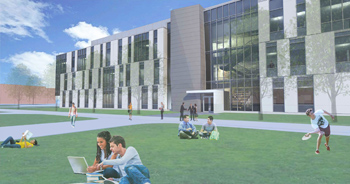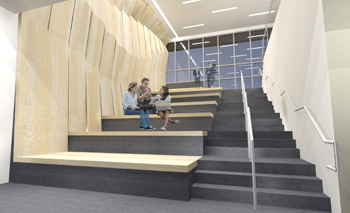SUNY Building Open for Business in 2014
 FARMINGDALE, N.Y. — Business is booming in Farmingdale, N.Y, as the new $26.7 million School of Business at Farmingdale State College part of the State University of New York (SUNY) campuses, has recently broke ground.
FARMINGDALE, N.Y. — Business is booming in Farmingdale, N.Y, as the new $26.7 million School of Business at Farmingdale State College part of the State University of New York (SUNY) campuses, has recently broke ground.
The 42,000-square-foot facility is slated for completion in 2014 and is part of a $185 million campus-wide capital campaign to expand and modernize the school. Islandia, N.Y.-based Stalco Construction is working as the general contractor on the new School of Business along with New York-based architecture firm, Urbahn Architects.
“The new, three-story, $26.7 million School of Business will be one of the most architecturally prominent higher education structures in the Northeast, said Joseph Serpe, vice president at Stalco Construction. “The building, which aims at LEED Silver certification, will feature a striking, modern, charcoal and ivory-colored façade, expansive glass curtainwall and a high number of environmentally responsible design and engineering solutions. The school’s energy efficiency performance will exceed New York’s state requirements by 30 percent.”
The need for the facility is due to the college’s increasing enrollment — which in 2012 exceeded 8,000 students. The school will help to prepare students for careers in the business industry by providing the latest technologies and services.
The building features a 1,050-square-foot computer lab that students will be able to work on assignments and projects as well as conduct research. While students have the option of working solo in the lab, the interior classroom space gives them the opportunity to work collaboratively.
The classrooms and lounges were designed with collaborative learning in mind. The first floor of the building features the largest classrooms in the building, and in order to promote active discussion and learning, each of these classrooms is tiered on each side around a centrally located teaching stage area. One of the 64-seat classrooms will feature a central folding partition, allowing division into two smaller, traditionally laid out classrooms.
The flexibility of the classrooms gives students and teachers endless learning possibilities, strategies and approaches.
“From the beginning of the project, it was the goal of Farmingdale State College for the building to promote a casual interaction between students and faculty,” said Peter Verne, senior associate at Urbahn Architects and project’s lead designer. “We reflected this concept in our design approach by locating the faculty offices immediately across the main corridors from the classrooms.”
The interior of the building also features mini-lounges for students, which further promotes interactivity. In addition to the public spaces, there are also two main lounges for students who prefer to work in a quiet working environment.
Green Elements
The building has many environmentally friendly features, including the mechanical, electrical and plumbing services.
 “The building will incorporate high efficiency heating, cooling and lighting systems that will significantly reduce energy use,” said Gregory Sibley, associate principal for Vanderweill Engineers. “The entire building will be managed by the Direct Digital Control (DDC)-controlled Building Energy Management System, which will optimize the energy use based on occupancy, air quality, natural lighting levels and other variable factors. The college’s facility management team will be able to control the building’s systems remotely, from the campuses’ central control room.”
“The building will incorporate high efficiency heating, cooling and lighting systems that will significantly reduce energy use,” said Gregory Sibley, associate principal for Vanderweill Engineers. “The entire building will be managed by the Direct Digital Control (DDC)-controlled Building Energy Management System, which will optimize the energy use based on occupancy, air quality, natural lighting levels and other variable factors. The college’s facility management team will be able to control the building’s systems remotely, from the campuses’ central control room.”
The cooling system at the facility will include two high efficiency, water cooled, 135-ton chillers in the basement as well as cooling towers, tied to the basement chillers, on the grade level outside of the main building. The chilled water will be distributed through piping networks to custom manufactured air handling units with multiple fans for an increased redundancy and reliability. The units will also feature internal service corridors for easier maintenance.
“In order to develop the optimal structure, the architectural and engineering team performed multiple modeling tests for the entire building’s design, including walls, ceilings, roofs and MEP systems,” said Sibley. “This analysis has led to the development of an extremely efficient structure that will serve as an example for future higher education facilities across the nation.”
The greening of the new building will also serve as an example for other campus projects — along with incorporating collaborative learning spaces within other new facilities.
